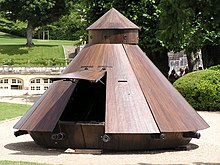Clos Lucé Castle
The Clos Lucé Castle (also Château du Cloux ) is located in Amboise , about 500 meters from the Loire Castle Amboise , to which there is an underground connection. It is the place of the last work and death of the artist and polymath Leonardo da Vinci .
history
Clos Lucé was built by Étienne le Loup in the middle of the 15th century. In 1490 the French King Charles VIII bought it for his wife Anne de Bretagne . It was later used by King Francis I and his sister Margaret of Navarre , who began to write her book L'Heptaméron there.
In 1516 Francis I invited Leonardo da Vinci to Amboise and gave him Clos Lucé as a place to live and work. Leonardo brought three paintings: the Mona Lisa , Anna Selbdritt and John the Baptist . He lived there for three years until his death on May 2, 1519.
Da Vinci Museum
Today, Clos Lucé is a Leonardo da Vinci museum, in which, in addition to testimonies to the region's significant past, Leonardo's designs and numerous models of his constructions and inventions, copies of some paintings and quotations from his notes are on display.
In one of the core sentences shown it says: “To preserve the most important gift of nature, by that I mean freedom, I know how to attack and defend myself in the event of a siege by power-hungry tyrants.” (French: “Pour conserver le don principal de la nature, c'est à dire la liberté, je sais comment attaquer et défendre en cas de sièges par les ambitieux tyrans. ")
Architecture and interior
Castle Clos Lucé, which has now belonged to the St-Bris family for generations, has the character of a fortified castle with a peep tower, loopholes, sentry box and (remains) drawbridge despite its extensive gardens, the large brick dovecote and the surrounding vineyards. From 1955 Hubert St-Bris pursued the goal of restoring the condition of the facility as much as possible to the time of its famous resident Leonardo da Vinci. The extensive restoration was carried out by the architect Bernard Vitry from “ Monuments historiques ”.
The living spaces in particular have been restored to their former glory:
- the prayer chapel that Charles VIII had built for his wife Anna of Brittany,
- the salons with their paneling from the 18th century,
- the great renaissance hall, Leonardo's reception room,
- the kitchen with the huge fireplace,
- the rooms in the basement.
The terrace of the Renaissance garden offers a view of the city and castle.
literature
- Castles on the Loire . The Green Guide. Travel House Media, Munich 2010, ISBN 978-3-8342-8962-9 , p. 156.
- Castles and cities of the Loire . Casa Editrice Bonechi, Florence, ISBN 88-476-1863-0 , p. 92.
Web links
Coordinates: 47 ° 24 ′ 36 ″ N , 0 ° 59 ′ 29 ″ E








